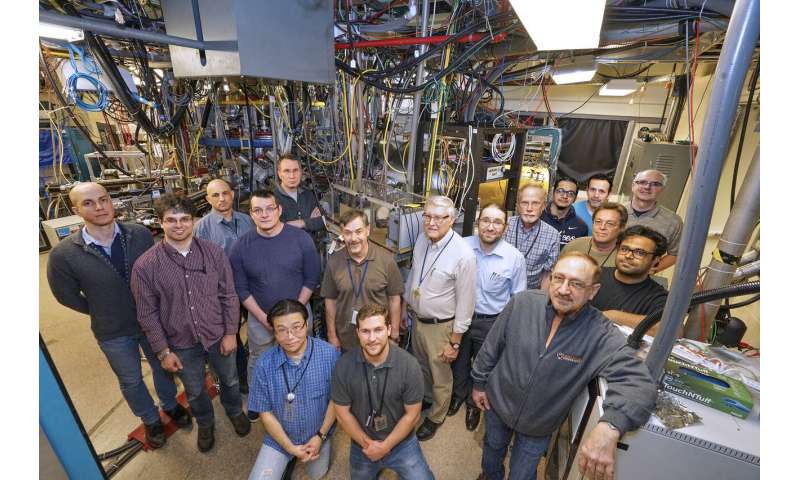
Lithium, the silvery metal that powers smart phones and helps treat bipolar disorders, could also play a significant role in the worldwide effort to harvest on Earth the safe, clean and virtually limitless fusion energy that powers the sun and stars. First results of the extensively upgraded Lithium Tokamak Experiment-Beta (LTX-β) at the U.S. Department of Energy's (DOE) Princeton Plasma Physics Laboratory (PPPL), demonstrate that the major enhancements operate as designed and improve the performance of the hot, charged plasma that will fuel future fusion reactors.
More fusion-relevant
The three-year upgrade turned what is now the LTX-β into a hotter, denser and more fusion-relevant device that will test how well coating all plasma-facing walls with liquid lithium can improve the confinement and increase the temperature of the plasma. "We achieved many of our initial engineering goals," said physicist Drew Elliott of Oak Ridge National Laboratory, a major collaborator of the LTX-β. Elliott, on long-term assignment to PPPL, served as lead author of the first results paper reported in IEEE Transactions in Plasma Science.
Fusion reactions combine light elements in the form of plasma—the state of matter composed of free electrons and atomic nuclei that makes up 99% of the visible universe—to release enormous amounts of energy. Physicists around the world are seeking to duplicate and control fusion reactions to create boundless safe, carbon-free power to generate electricity.
Key features of the LTX-β, a smaller version of the widely used doughnut-shaped magnetic tokamak facilities that house fusion reactions, include these factors: A powerful neutral beam injector to heat and fuel the plasma; a nearly doubled magnetic field compared with the previous device; and a twin evaporation system to fully coat liquid lithium on all the plasma-facing surfaces.
Matched predictions
Operation of the beam matched well with predictions of the fraction of power that it would deposit into the plasma, rather than simply shining through it. "We're looking to increase the power deposition toward 100% so that all the power we inject goes into the plasma," said Elliott, who led the optimization of the neutral beam, which is based on technology pioneered at ORNL in the 1970s. "That will be a big scientific push, in future campaigns."
The substantial enhancements aim to test whether the LTX-β can improve plasma performance beyond the notable achievements of its predecessor. These include the demonstration of temperatures that remain constant, or flat, all the way from the hot core of the plasma to the normally cool outer edge.
Such gradient-free temperature profiles, the first ever seen in a magnetic fusion facility in the previous device, stem from the ability of lithium to hold onto stray particles that leak from the core of the plasma and keep them from recycling back and cooling the edge and core of the plasma. Sustainment of the hot edge expands the volume of plasma available for fusion and the production of flat temperature prevents instabilities that reduce plasma confinement from developing.
Goals of the upgrade
"The goals of the upgrade are to determine whether very low recycling lithium walls can improve plasma confinement in a tokamak with neutral beam heating," said Dick Majeski, principal investigator for LTX-β. "If LTX-β is successful, we can move on to experiments on liquid lithium in the National Spherical Torus Experiment-Upgrade [NSTX-U]," the flagship fusion experiment at PPPL.
The initial run of the LTX-β demonstrated improvements that included the following:
- Increased fueling and density of the plasma, major goals of the neutral beam injector;
- Increased deposition of liquid lithium over more than 90% of the inner walls of the LTX-β;
- Longer plasma discharges, or pulses, enabled by the strengthened magnetic field; and
- Higher plasma current—a critical element that causes the magnetic field to spiral, which is necessary to confine the plasma.
Also installed in the upgrade are new plasma diagnostics that will further characterize the facility's expanded operating regime. And still to be commissioned are advanced diagnostics that will measure the precise profile of several plasma parameters.
"The addition of the neutral beam increases the input power to the plasma by an order of magnitude and has the potential of creating a fusion-relevant plasma regime with enhanced performance," said Phil Efthimion, head of PPPL's Plasma Science & Technology Department that includes the LTX-β. "Dick Majeski and the entire LTX-β team should be commended for completing this aggressive upgrade on budget and schedule.
Experts across the U.S.
The upgrade pulled from experts across the United States, including collaboration from PPPL, ORNL, Princeton University, the University of California, Los Angeles (UCLA), and the University of Tennessee, Knoxville, and provides a significant tool for fusion research.
"ORNL and PPPL have been partners in fusion science and technology for many years, and this continues that strong union," said Mickey Wade, director of ORNL's Fusion Energy Division. "LTX-β will allow the fusion community to dig deeper into the promise of lithium and what it could unlock in enabling practical fusion energy."
Majeski has big plans ahead. "In the future, we'd like to increase the pulse length of the neutral beam to provide a longer period of heating and fueling for the plasma," he said. "The beam adds a lot of flexibility to the experiment, and we want to take advantage of the new capabilities."
Explore further
Citation: First results of an upgraded device highlight lithium's value for producing fusion (2020, July 29) retrieved 30 July 2020 from https://ift.tt/3hTMqL7
This document is subject to copyright. Apart from any fair dealing for the purpose of private study or research, no part may be reproduced without the written permission. The content is provided for information purposes only.
July 30, 2020 at 03:02AM
https://ift.tt/30eC0Qe
First results of an upgraded device highlight lithium's value for producing fusion - Phys.org
https://ift.tt/3hIQ4rV
/article-new/2021/06/iphone-13-duan-rui2.jpeg?lossy)
No comments:
Post a Comment